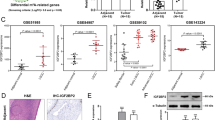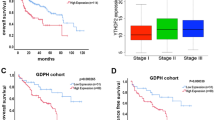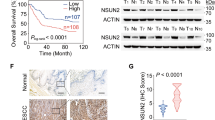Abstract
We identified that suppressor of cytokine signaling-3 (SOCS-3) gene was aberrantly methylated in its CpG island in three of 10 human hepatocellular carcinoma (HCC) cell lines. SOCS-3 RNA was undetectable in five of the 10 HCC cell lines including the three methylated cell lines, and a demethylating agent, 5-aza-2′-deoxycytidine, reactivated SOCS-3 expression in three cell lines tested. The DNA region where we found aberrant DNA methylation includes a signal transducers and activators of transcription (STAT) binding consensus sequence. When the DNA region was used as a promoter, DNA methylation markedly reduced promoter activity. SOCS-3 was also aberrantly methylated in six of 18 primary HCC samples. SOCS-3 expression was reduced in three of the three methylated and one of the three unmethylated primary samples examined. Restoration of SOCS-3 in cells lacking SOCS-3 expression suppressed STAT3 phosphorylation and cell growth. We found that IL-6 acted as a growth factor in HCC cells. Inhibition of SOCS-3 expression in cells whose growth was induced by IL-6 enhanced STAT3 phosphorylation and cell growth. In addition, AG490, a chemical JAK2 inhibitor, suppressed cell growth and downregulated STAT3 phosphorylation, but not FAK phosphorylation. We also found that SOCS-3 physically interacted with phosphorylated FAK and Elongin B in HCC cells. Restoration of SOCS-3 decreased FAK phosphorylation as well as FAK protein level. Inhibition of SOCS-3 expression increased FAK phosphorylation, resulting in enhancement of cell migration. These data indicate that SOCS-3 negatively regulates cell growth and cell motility by inhibiting Janus kinase (JAK)/STAT and FAK signalings in HCC cells. Thus, loss of SOCS-3 by the associated DNA methylation confers cells advantage in growth and migration.
This is a preview of subscription content, access via your institution
Access options
Subscribe to this journal
Receive 50 print issues and online access
$259.00 per year
only $5.18 per issue
Buy this article
- Purchase on Springer Link
- Instant access to full article PDF
Prices may be subject to local taxes which are calculated during checkout





Similar content being viewed by others
Accession codes
Abbreviations
- JAK:
-
Janus kinase
- STAT:
-
signal transducers and activators of transcription
- SOCS:
-
suppressors of cytokine signaling
- HCC:
-
hepatocellular carcinoma
- FAK:
-
focal adhesion kinase
- RLGS:
-
restriction landmark genomic scanning
- MSP:
-
methylation-specific PCR
- 5Aza-dC:
-
5-aza-2′-deoxycytidine
- TSA:
-
trichostatin A
References
Auernhammer CJ, Bousquet C and Melmed S . (1999). Proc. Natl. Acad. Sci. USA, 96, 6964–6969.
Cary LA, Chang JF and Guan JL . (1996). J. Cell Sci., 109 (Part 7), 1787–1794.
Catlett-Falcone R, Landowski TH, Oshiro MM, Turkson J, Levitzki A, Savino R, Ciliberto G, Moscinski L, Fernandez-Luna JL, Nunez G, Dalton WS and Jove R . (1999). Immunity, 10, 105–115.
Cobb BS, Schaller MD, Leu TH and Parsons JT . (1994). Mol. Cell. Biol., 14, 147–155.
Darnell Jr JE, Kerr IM and Stark GR . (1994). Science, 264, 1415–1421.
Edmondson HA and Steiner PE . (1954). Cancer, 7, 462–503.
Endo TA, Masuhara M, Yokouchi M, Suzuki R, Sakamoto H, Mitsui K, Matsumoto A, Tanimura S, Ohtsubo M, Misawa H, Miyazaki T, Leonor N, Taniguchi T, Fujita T, Kanakura Y, Komiya S and Yoshimura A . (1997). Nature, 387, 921–924.
Garcia R, Yu CL, Hudnall A, Catlett R, Nelson KL, Smithgall T, Fujita DJ, Ethier SP and Jove R . (1997). Cell Growth Differ., 8, 1267–1276.
He B, You L, Uematsu K, Zang K, Xu Z, Lee AY, Costello JF, McCormick F and Jablons DM . (2003). Proc. Natl. Acad. Sci. USA, 100, 14133–14138.
Herman JG, Civin CI, Issa JP, Collector MI, Sharkis SJ and Baylin SB . (1997). Cancer Res., 57, 837–841.
Herman JG, Graff JR, Myohanen S, Nelkin BD and Baylin SB . (1996). Proc. Natl. Acad. Sci. USA, 93, 9821–9826.
Ihle JN . (1996). Cell, 84, 331–334.
Ilic D, Furuta Y, Kanazawa S, Takeda N, Sobue K, Nakatsuji N, Nomura S, Fujimoto J, Okada M and Yamamoto T . (1995). Nature, 377, 539–544.
Kamizono S, Hanada T, Yasukawa H, Minoguchi S, Kato R, Minoguchi M, Hattori K, Hatakeyama S, Yada M, Morita S, Kitamura T, Kato H, Nakayama K and Yoshimura A . (2001). J. Biol. Chem., 276, 12530–12538.
Kawano M, Hirano T, Matsuda T, Taga T, Horii Y, Iwato K, Asaoku H, Tang B, Tanabe O, Tanaka H, Kuramoto A and Kishimoto T . (1988). Nature, 332, 83–85.
Kishimoto T, Taga T and Akira S . (1994). Cell, 76, 253–262.
Kubo T, Yamamoto J, Shikauchi Y, Niwa Y, Matsubara K and Yoshikawa H . (2004). Cancer Res., 64, 5172–5177.
Lacronique V, Boureux A, Valle VD, Poirel H, Quang CT, Mauchauffe M, Berthou C, Lessard M, Berger R, Ghysdael J and Bernard OA . (1997). Science, 278, 1309–1312.
Lipfert L, Haimovich B, Schaller MD, Cobb BS, Parsons JT and Brugge JS . (1992). J. Cell Biol., 119, 905–912.
Liu E, Cote JF and Vuori K . (2003). EMBO J., 22, 5036–5046.
Luo H, Hanratty WP and Dearolf CR . (1995). EMBO J., 14, 1412–1420.
Miki S, Iwano M, Miki Y, Yamamoto M, Tang B, Yokokawa K, Sonoda T, Hirano T and Kishimoto T . (1989). FEBS Lett., 250, 607–610.
Nagamori S, Hasumura S, Matsuura T, Aizaki H and Kawada M . (2000). J. Gastroenterol., 35, 493–503.
Naka T, Narazaki M, Hirata M, Matsumoto T, Minamoto S, Aono A, Nishimoto N, Kajita T, Taga T, Yoshizaki K, Akira S and Kishimoto T . (1997). Nature, 387, 924–929.
Owens LV, Xu L, Craven RJ, Dent GA, Weiner TM, Kornberg L, Liu ET and Cance WG . (1995). Cancer Res., 55, 2752–2755.
Sasaki A, Inagaki-Ohara K, Yoshida T, Yamanaka A, Sasaki M, Yasukawa H, Koromilas AE and Yoshimura A . (2003). J. Biol. Chem., 278, 2432–2436.
Schaller MD, Borgman CA, Cobb BS, Vines RR, Reynolds AB and Parsons JT . (1992). Proc. Natl. Acad. Sci. USA, 89, 5192–5196.
Schaller MD, Hildebrand JD, Shannon JD, Fox JW, Vines RR and Parsons JT . (1994). Mol. Cell. Biol., 14, 1680–1688.
Starr R, Willson TA, Viney EM, Murray LJ, Rayner JR, Jenkins BJ, Gonda TJ, Alexander WS, Metcalf D, Nicola NA and Hilton DJ . (1997). Nature, 387, 917–921.
The French METAVIR cooperative study group (1994). Hepatology, 20, 15–20.
Weber-Nordt RM, Egen C, Wehinger J, Ludwig W, Gouilleux-Gruart V, Mertelsmann R and Finke J . (1996). Blood, 88, 809–816.
Yoshida T, Ogata H, Kamio M, Joo A, Shiraishi H, Tokunaga Y, Sata M, Nagai H and Yoshimura A . (2004). J. Exp. Med., 199, 1701–1707.
Yoshikawa H, de la Monte S, Nagai H, Wands JR, Matsubara K and Fujiyama A . (1996). Genomics, 31, 28–35.
Yoshikawa H, Fujiyama A, Nakai K, Inazawa J and Matsubara K . (1998). Genomics, 49, 237–246.
Yoshikawa H, Matsubara K, Qian GS, Jackson P, Groopman JD, Manning JE, Harris CC and Herman JG . (2001). Nat. Genet., 28, 29–35.
Yoshikawa H, Nagai H, Oh KS, Tamai S, Fujiyama A, Nakanishi T, Kajiyama G and Matsubara K . (1997). Gene, 197, 129–135.
Yoshimura A, Ohkubo T, Kiguchi T, Jenkins NA, Gilbert DJ, Copeland NG, Hara T and Miyajima A . (1995). EMBO J., 14, 2816–2826.
Zhang JG, Farley A, Nicholson SE, Willson TA, Zugaro LM, Simpson RJ, Moritz RL, Cary D, Richardson R, Hausmann G, Kile BJ, Kent SB, Alexander WS, Metcalf D, Hilton DJ, Nicola NA and Baca M . (1999). Proc. Natl. Acad. Sci. USA, 96, 2071–2076.
Zimmers TA, McKillop IH, Pierce RH, Yoo JY and Koniaris LG . (2003). Hepatology, 38, 326–334.
Acknowledgements
This research was supported in part by Grant-in-Aid for Scientific Research (S) from Japan Society for the Promotion of Science.
Author information
Authors and Affiliations
Corresponding author
Rights and permissions
About this article
Cite this article
Niwa, Y., Kanda, H., Shikauchi, Y. et al. Methylation silencing of SOCS-3 promotes cell growth and migration by enhancing JAK/STAT and FAK signalings in human hepatocellular carcinoma. Oncogene 24, 6406–6417 (2005). https://doi.org/10.1038/sj.onc.1208788
Received:
Revised:
Accepted:
Published:
Issue Date:
DOI: https://doi.org/10.1038/sj.onc.1208788
Keywords
This article is cited by
-
Kremen2 drives the progression of non-small cell lung cancer by preventing SOCS3-mediated degradation of EGFR
Journal of Experimental & Clinical Cancer Research (2023)
-
The E3 ubiquitin ligase SOCS-7 reverses immunosuppression via Shc1 signaling in hepatocellular carcinoma
Laboratory Investigation (2022)
-
Potentials of long non-coding RNAs as biomarkers of colorectal cancer
Clinical and Translational Oncology (2022)
-
Epigenome-wide analysis of T-cell large granular lymphocytic leukemia identifies BCL11B as a potential biomarker
Clinical Epigenetics (2022)
-
Inhibition of CUB and sushi multiple domains 1 (CSMD1) expression by miRNA-190a-3p enhances hypertrophic scar-derived fibroblast migration in vitro
BMC Genomics (2021)



